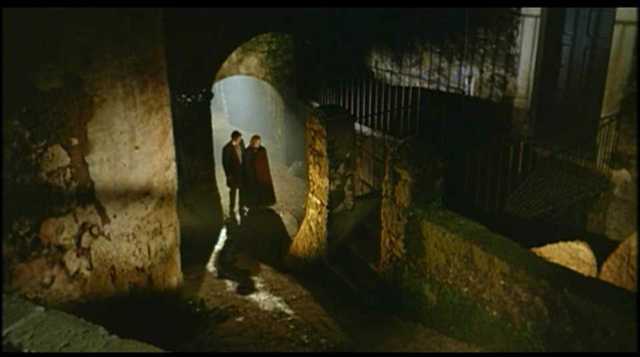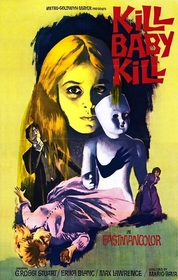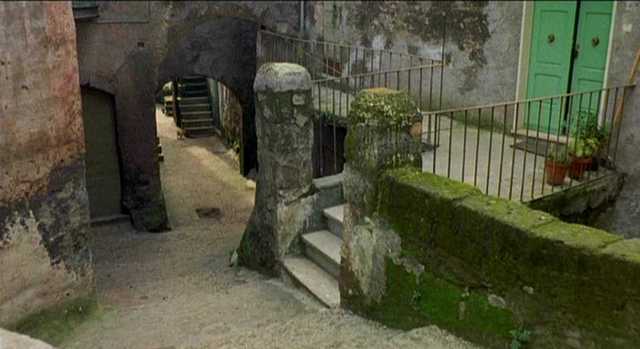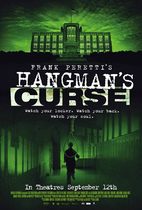Our editor-in-chief Nate Yapp is proud to have contributed to the new book Hidden Horror: A Celebration of 101 Underrated and Overlooked Fright Flicks, edited by Aaron Christensen. Another contributors include Anthony Timpone, B.J. Colangelo, Dave Alexander, Classic-Horror.com's own Robert C. Ring and John W. Bowen. Pick up a copy today from Amazon.com!
Kill, Baby... Kill! (1966)
What’s in a name? That which we know as the inapt Kill, Baby… Kill! by any of its other titles (including Operazione paura and Curse of the Living Dead) would still fail to tell us anything useful about the film. You could say that Kill, Baby... Kill! suffers from the ignominious efforts of its distributors to find a title for it, but I say that their failures are to the film’s benefit. Certainly, there is no epithet of which I can conceive that accurately captures the beauty of Bava’s chilling period Gothic; it is a near-perfect synthesis of vision, sound, and plot that revels in ambiguities, role reversals, and sheer, unsettling atmosphere.
After a shocking pre-title sequence that piques the interest without giving away any significant plot details, Kill, Baby… Kill! really gets started with the arrival of Dr. Paul Eswai (Giacomo Rossi-Stuart) to Karmingen, a village isolated from any major cities. Paul is responding to the summons of Inspector Kruger, a police detective who is trying to discover if the strange death of one of the locals was an accident or murder. However, the frightened villagers refuse to talk about what they know, if anything at all. They certainly won’t discuss the curse on the town or the creepy little girl who appears to people right before they inexplicably take their own lives. The witch Ruth (Fabienne Dali) knows more than she lets on, but even she will not break the town’s silence. Paul and his assistant Monica (Erika Blanc, The Devil’s Nightmare) discover the secret of the curse may lie in Villa Graps, a rotting old mansion where the Baroness Graps (Giovanna Galletti) has mourned the death of her daughter Melissa for the past twenty years.
Paul’s journey through Kill, Baby… Kill! is one of science vs. reason, the “new” medicine of 1907 fighting the medieval superstitions of Karmingen. However, Paul’s science and deductive reasoning are unwelcome intruders in the village and his presence does more harm than good. Late in the film, the Burgomaster informs Paul that the curse has killed ten people in the “past few years” (if “few” means “three”, then that’s about three a year). In the course of the single night in which most of Kill, Baby… Kill! takes place, five die and three of those deaths can be attributed (directly or indirectly) to the active investigation of the curse by Paul and Inspector Kruger. Between the two of them, they have accelerated the rate of curse-related homicide in the area by a factor of 365.
Science and reason cannot end the curse; supernatural forces must be met in kind, and as such, the witch Ruth is the only person capable bringing this reign of terror to an end. Ruth is one of the many role reversals found in Kill, Baby… Kill! – not only as a “good” witch fighting an “evil” little girl, but as a supporting character who actively effects the resolution of the plot, a role typically filled by the stalwart male lead or the guileless ingénue. From a story standpoint, this appears all wrong, but looking at Ruth’s position within Karmingen, it is exactly right. For the people of the village, she is likely the most important citizen, acting as both priestess and healer. In the priestess role, she offers rituals and rules on how to ward off evil spirits, a comforting dogma to allow the villagers a little peace of mind. As healer, she is called upon (or simply arrives of her own accord) when the ghost of Melissa Graps selects a victim. Her “cures” are also rituals, but instead of being merely quaint, they are barbaric acts of no discernable medicinal value, like forcing the teenage daughter of the local innkeeper to wear a length of barbed wire around her midsection (although the events of the film suggest that such torture is better than the wrath of Melissa). Ironically, Ruth is still an outcast, despite her importance. After ministering to the girl at the inn, she is ushered out a side door, so that no one will know she was there. There we have a role reversal on a role reversal – the typically outcast witch is the town’s VIP, but the town’s VIP is still an outcast.
Perhaps the single most fascinating figure in Kill, Baby… Kill! is Melissa Graps herself. She’s not the first creepy little blond girl in cinematic history; Rhoda Penmark (Patty McCormack) in The Bad Seed is the most obvious example, but Rhoda was a creature of flesh and blood, a human sociopath. Melissa is a supernatural force, something beyond a three-foot-something child in patent leather Mary Janes. As if to emphasize this, half the character's presence is created using only Bava’s direction. In some places, Melissa’s presence is indicated by ethereal giggling on the soundtrack, a creepy music box dirge that acts as Melissa’s theme, or a bouncing white ball thrown by invisible hands. In a few instances, Bava’s camera becomes Melissa, most notably the second time we meet her. Outside the mortuary where Paul and Monica are performing an autopsy, Melissa’s theme plays, the giggling begins, and the camera moves suddenly forward, then back, forward and back – a girl on a swing. This sequence is slightly marred by the fact that the camera does not quite move with the grace or fluidity of a traditional swingset, but the subversion of the symbols of innocence into creepy inspirations of dread is such a perfect summation of Melissa that technical limitations are forgiven.
Bava wisely keeps Melissa’s physical manifestations minimal in order to squeeze every drop of effectiveness out of them. When we do finally glimpse the girl’s face, twenty-three minutes into the film, it is one of the creepiest moments in Kill, Baby… Kill! Bava has primed the scene with the right music and a teenage girl already terrified because she accidentally slipped important plot information to Paul. The music comes to a head, there is a roll of drums, and the girl screams. Bava cuts to a shock-zoom of Melissa peering in through the window, her hands pressed against the grimy glass. The window grille divides our view of her face, but even excepting that, there is something not quite right. Later in the film, eagle eyes may note a certain unfeminine something about Melissa’s countenance, which might come as a relief to Melissa’s actor, a dark-haired boy named Valerio Valeri. After auditioning dozens of little girls for the part of Melissa, Bava came across Valeri quite by chance and cast him in the part1. The vaguely male face under those blond flowing locks (a wig) adds to Melissa's unsettling effect on the audience.
Shaking up the nerves is a specialty of all things Graps in Kill, Baby… Kill! In particular, Villa Graps becomes a strange, wild spook-house of hallucinatory thrills for Paul and Monica towards the end of the film. Melissa absconds with Monica at a key point in the scene, and Paul gives pursuit, running into a dusty room with a cobwebbed painting of the mansion in the background. He chases Monica’s voice through the door at the far end of the room and ends up in the same room. Confused, but spurred on by Monica’s cries for help, he continues through the far door again and again ends up where he started. Paul increases speed and ends up cycling through the same room over and over, but as his pursuit becomes more heated, he starts entering the room before he’s left it, watching himself leave just as he’s coming in. Eventually he catches up with himself, but his other self laughs and then disappears, a ghastly mirage. Finally, when Paul tries to catch his breath by leaning against the painting, he falls back into the art, which leads to a giant cobweb outside the real mansion. Later, Monica, running from Melissa’s vengeful spirit, descends a spiral staircase (which may be the greatest of all spiral staircases in the history of cinema) that seems to twist into infinity. No matter what progress she seems to make, there is more spiral staircase yet to go; to add insult to injury, the camera begins spinning clockwise, against Monica’s counter-clockwise descent, as if to negate her movement entirely. Bava seems to be having the most fun in these two sections, and why not? As a recognized master of camera tricks and matte effects in Italy, he must have loved the idea of creating illusions within the world of the film rather than simply around it.
From the camera’s prowl through the decrepit streets of Karmingen during the opening credits to the gorgeous sunset at film’s end, from the ever-present swirling mist to the arrays of colored lights that add a layer of psychedelia to the proceedings, Bava serves up a feast of visual delights in Kill, Baby… Kill! Bava had been a much-sought cinematographer in the 1950s and, although the photography is credited Antonio Rinaldi, it is Bava’s mastery that is felt throughout the film. A post made to Tim Lucas’s Video WatchBlog on September 16, 2007, entitled “Believe in What You Think You See” demonstrates this superbly, and I've borrowed two images from the post with Lucas's kind permission. Note this still, taken from a well-lit shot in Bava’s Lisa and the Devil:
Now, compare it to the malevolent darkness of the second still, taken from Kill, Baby… Kill!:

According to Lucas's post, both scenes were filmed in Faleria, Italy, and depict the same street from the same angle. However, atmosphere reigns in Kill, Baby… Kill! Not only has night fallen on this town, but so too has the Underworld, with shadows and fog dancing with an implicit promise of terror.
As a canvas upon which Bava can paint the dread atmosphere of the fictional Karmingen, Faleria is perfection. The fictional village is supposedly cursed and Faleria, which was devastated by an earthquake in 19422, looks the part – moss grows wild, the streets are in disrepair, and even the walls have fallen away in some places. Twisting corridors and sudden flights of stairs create an oppressive labyrinth that Paul and Monica must navigate. Karmingen is depicted as an ancient village coming to its end because evil (or the village’s belief in evil) has made its home there; together, the ruined structures of Faleria and the exacting camera of Bava turn this micro-apocalypse into a visual truth.
Equally effective are the locations and sets that comprise Villa Graps, the mansion on the outskirts of town where Baroness Graps makes her permanent home. Where Karmingen is broken and unkempt, Villa Graps is overcome with decay and ruin. Rot has overtaken whatever the cobwebs haven’t claimed for their own. The Baroness has attempted, through inaction, to keep the mansion trapped in the day that her daughter Melissa died, but the ravages of time have had their way with the place all the same. It’s a shame, too, because Villa Graps would have been a palace in its day, with its suits of armor lining the main hall and the ornate torch holders on the walls. The contrast between what is and what was is breathtaking, bringing a sense of inevitable, slow decay that permeates the film.
The images set the scene and the action moves the plot, but it is music that brings the two together, enhancing both the atmosphere of the visuals and the emotional truth of the action. The perfect musical score, one that brings a new dimension to the suspense and mood, can elevate a great film to a masterpiece. Kill, Baby… Kill! has such a score. Never overly bombastic, it instead plays under the events of the film, lending its strange disquieting presence to moments that are already quite unnerving. More appropriate music could not be asked for, which makes the fact that the soundtrack of Kill, Baby… Kill! is entirely composed of tracks from other films (according to Tim Lucas’s supremely thorough biography “Mario Bava: All the Colors of the Dark”). Selections come from a wide variety of films, including Bava’s own The Whip and the Body. The chiming music box piece, which acts almost as a theme for Melissa Graps, the little girl ghost, is purloined from Ottavio Allesi’s comedy Che fine ha fatto Totò baby? (What Ever Happened to Baby Toto?). Bava likely had a large library of musical cues from which to make his selections; the resulting perfection of almost every choice leads me to believe that he must have devoted a significant amount of time to finding exactly the right piece for each scene.3
Mario Bava has been called the Maestro of the Macabre; Kill, Baby… Kill! is all the evidence one needs for the appropriateness of that distinction. The film is a near-perfect configuration of theme, atmosphere, and old-fashioned chills -- all in a compact 82 minutes. One of the great ghost stories in the history of cinema, the haunting power of Kill, Baby… Kill! resonates no matter what title it is seen under.
This review is part of Mario Bava Week, the last of four celebrations of master horror directors done for our Shocktober 2007 event.
- Lucas, Tim. Mario Bava: All the Colors of the Dark. Video Watchdog, 2007. Pages 670-671
- Ibid. Page 668.
- Ibid. Pages 672-673.









